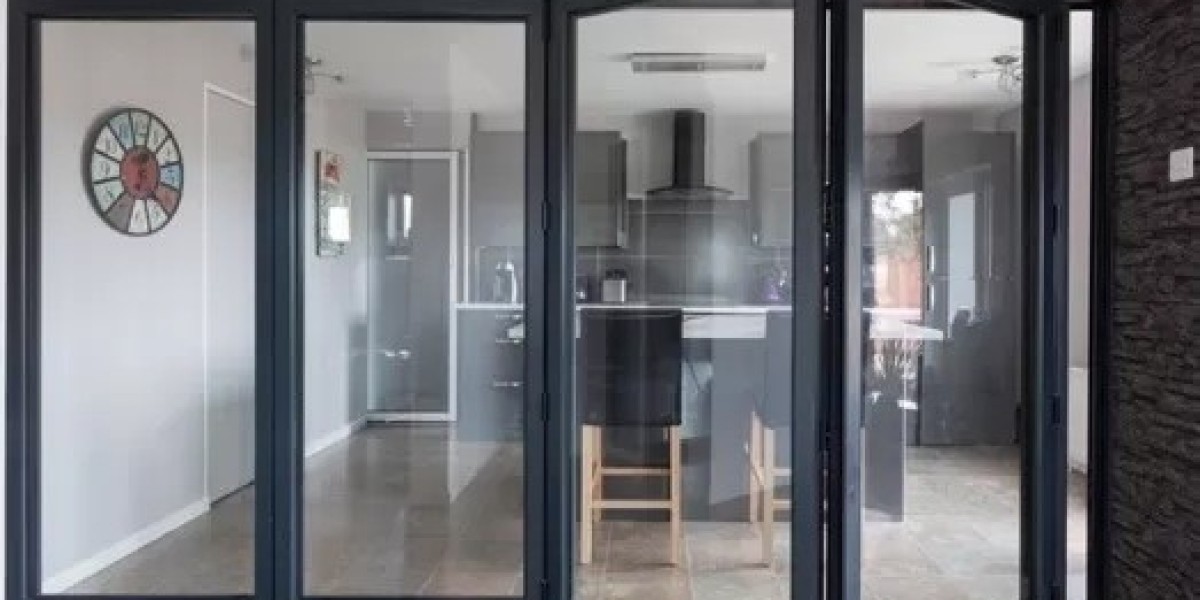Bi-folding Door Repair: A Comprehensive Guide to Troubleshooting and Maintenance
Bi-folding doors, likewise known as folding sliding doors or concertina doors, have actually risen in popularity in modern homes for their capability to seamlessly merge indoor and outdoor spaces. Their extensive glass panels flood spaces with natural light and develop an open, airy feel, making them a preferable feature for outdoor patios, conservatories, and room dividers. Nevertheless, like any mechanical system, bi-folding doors can come across problems in time, needing repair and maintenance to guarantee they continue to function efficiently and aesthetically.
This article works as an informative guide to understanding typical problems with bi-folding doors, supplying insights into DIY repair options and when it's best to contact a professional. We will also look into preventative upkeep suggestions to lengthen the life-span and optimum efficiency of these remarkable door systems.
Comprehending Common Bi-folding Door Problems
Before trying any repairs, it's vital to determine the particular issue impacting your bi-folding doors. A number of problems can arise, frequently coming from wear and tear, misalignment, or inappropriate upkeep. Here are some of the most frequently come across problems:
- Difficult Operation: Doors end up being stiff, difficult to open or close, or require extreme force. This can be due to friction in the tracks, hinges, or rollers.
- Squeaking or Grinding Noises: Annoying noises throughout operation frequently show an absence of lubrication, worn rollers, or particles in the tracks.
- Doors Dragging or Catching: Doors might scrape against the frame, flooring, or each other. This could represent misalignment, warping, or damaged rollers.
- Gaps or Draughts: Visible spaces between door panels or the frame can result in drafts, heat loss, and security issues. This might point to issues with seals, hinges, or the locking system.
- Water Leaks: Water ingress, specifically around the bottom of the doors, might show damaged weather condition seals or drain blockages.
- Locking Problems: Difficulties locking or opening the doors can be due to misalignment, a malfunctioning lock system, or issues with the handle.
- Harmed Rollers or Tracks: Worn, split, or damaged rollers and harmed tracks can seriously impede smooth operation and result in other issues.
- Loose or Damaged Hinges: Hinges are important for the folding action. Loose or broken hinges can trigger doors to sag, bind, and run poorly.
Do It Yourself Bi-folding Door Repairs: Tackling Common Issues
Many minor bi-folding door problems can be attended to with basic DIY skills and tools. Before starting any repair, guarantee you have the necessary safety devices, such as gloves and eye protection. Always describe the maker's guidelines if available and continue with caution.
Here's a breakdown of typical DIY repair tasks:
1. Lubrication and Cleaning:

- Identify Points of Friction: Locate hinges, rollers, tracks, and locking systems where friction appears obvious.
- Clean Tracks and Rollers: Use a stiff brush or vacuum cleaner to eliminate debris, dust, and dirt from the tracks. For rollers, thoroughly clean around each wheel.
- Apply Lubricant: Use a silicone-based lube particularly created for windows and doors on all moving parts. Prevent oil-based lubricants as they can bring in dust and grime. Spray lube moderately and www.repairmywindowsanddoors.co.uk wipe off any excess.
- Test Operation: Open and close the doors a number of times to distribute the lubricant and examine if the operation has enhanced.
2. Adjusting Rollers:
- Locate Roller Adjustment Screws: Most bi-folding door roller systems have modification screws, typically available from the side or top of the door panels. Consult your door's handbook if you are not sure of their area.
- Loosen Up Adjustment Screws: Use a screwdriver or Allen key to somewhat loosen the adjustment screws.
- Change Roller Height: Gently adjust the roller height to raise or reduce the door panel. This might need minor trial and error. Adjust in small increments and check the door operation after each modification.
- Tighten Adjustment Screws: Once smooth operation is accomplished, securely tighten up the adjustment screws to lock the rollers in location. Ensure you adjust all rollers similarly to maintain even weight distribution and positioning.
3. Tightening Hinges and Hardware:
- Inspect Hinges: Check all hinges for looseness or damage.
- Tighten Loose Screws: Use a screwdriver to tighten up any loose screws on hinges, manages, and locking systems. Be cautious not to overtighten and strip the screw heads.
- Replace Damaged Screws: If screws are stripped or harmed, replace them with appropriately sized replacements.
- Check Handle and Lock Fixings: Ensure handles and locking systems are securely attached and working properly.
4. Weather Seal Replacement:
- Identify Damaged Seals: Inspect weather seals around the door boundary for fractures, tears, or wear and tear.
- Eliminate Old Seals: Carefully remove the old weather condition seals, frequently they are push-fit or glued in place.
- Clean Seal Channel: Clean the channel where the weather seal sits to eliminate any debris or adhesive residue.
- Install New Seals: Cut the new weather seal to the correct length and thoroughly push or glue it into the channel, ensuring a tight and constant seal.
When to Call a Professional Bi-folding bifold door damage control Specialist
While DIY repairs can deal with small problems, certain issues require the know-how of a certified bi-folding door repair expert. Attempting complex repairs without the ideal understanding and tools can get worse the issue and potentially compromise the door's stability and safety.
Here are circumstances when expert help is strongly advised:
- Significant Misalignment: If you can not deal with dragging, capturing, or gaps with easy roller changes, it might show a more severe structural problem within the door frame or opening.
- Harmed Tracks or Rollers: Replacing tracks or rollers frequently needs customized tools and understanding of the door system. Attempting this yourself can be tough and may lead to more damage.
- Complex Locking Mechanism Faults: If you suspect a problem within the internal locking mechanism or if the locking system is complicated, expert diagnosis and repair are important to preserve security.
- Glass Panel Issues: Never attempt to repair or replace glass panels yourself. Broken or harmed glass panels need specialist handling and replacement to ensure security and appropriate sealing.
- Distorted or Damaged bifold door refurbishers Panels: Warped or considerably harmed door panels often need expert assessment to determine the cause and suitable repair or replacement.
- Repeating Problems: If you discover yourself often carrying out the exact same DIY repairs, it might suggest an underlying concern that needs expert attention to avoid future issues.
- Doors Under Warranty: Performing DIY repairs on doors still under warranty might void the service warranty. Constantly seek advice from the warranty terms before trying any repairs yourself.
Preventative Maintenance: Ensuring Longevity
Proactive maintenance is crucial to avoiding lots of bi-folding door problems and extending their lifespan. Routine care can conserve you time, money, and disappointment in the long run.
Here are important preventative upkeep pointers:
- Regular Cleaning: Clean tracks and rollers regularly (at least every few months, or more frequently in dirty environments) to avoid particles build-up.
- Lubrication: Lubricate moving parts (hinges, rollers, locks) a minimum of two times a year, or as needed, using a silicone-based lubricant.
- Examination of Weather Seals: Inspect weather seals annually for damage and replace them without delay to prevent drafts and water leakages.
- Inspect Fixings: Periodically check and tighten up screws on hinges, deals with, and locking mechanisms.
- Gentle Operation: Avoid forcing the doors open or closed. If they are stiff, investigate the cause instead of using excessive force.
- Expert Servicing: Consider annual or bi-annual expert servicing and evaluation, particularly for complex systems, to capture possible problems early and guarantee optimal efficiency.
Conclusion
Bi-folding doors are a stunning addition to any home, enhancing both visual appeals and functionality. Understanding common repair requirements and practicing preventative upkeep will make sure these doors continue to operate efficiently and reliably for many years to come. While DIY repairs appropriate for small problems, recognizing when to seek expert assistance is essential for complex issues and maintaining the stability and security of your bi-folding door system. By integrating proactive maintenance with notified repair choices, you can enjoy the advantages of your bi-folding doors without unneeded inconvenience and cost.
Often Asked Questions (FAQs)
Q: How often should I lubricate my bi-folding door hinges and rollers?
A: It is recommended to oil bi-folding door hinges and rollers a minimum of twice a year. However, in dusty or seaside environments, you may need to lubricate them more regularly, perhaps every 3-4 months. Listen for squeaking or tightness-- these are excellent indicators that lubrication is required.
Q: What kind of lubricant should I utilize for my bi-folding doors?
A: Use a silicone-based lubricant particularly designed for fixing bifold doors and windows. Silicone lubes are effective at lowering friction and are less likely to draw in dust and gunk compared to oil-based lubricants. Avoid using WD-40 as a long-lasting lube as it can dry out and bring in dust.
Q: Can I adjust bi-folding door rollers myself?
A: Yes, standard roller changes are frequently DIY-friendly. Locate the adjustment screws (refer to your door handbook if needed), and use a screwdriver or Allen secret to make little adjustments. Keep in mind to adjust all rollers equally and test operation after each modification. If you're not sure or the changes don't resolve the issue, seek advice from a professional.
Q: How do I clean bi-folding door tracks?

A: Use a stiff brush or vacuum with a crevice tool to eliminate dust, dirt, and particles from the tracks. For stubborn grime, you can use a moist cloth or moderate soapy water, ensuring you dry the tracks completely afterwards. Regular cleaning is necessary for smooth operation.
Q: My bi-folding doors are dripping water at the bottom. What could be the issue?
A: Water leaks at the bottom of bi-folding doors can be triggered by several issues:
- Damaged or Deteriorated Weather Seals: Inspect and replace any broken weather condition seals along the bottom edge of the doors.
- Blocked Drainage Holes: Check for drain holes at the bottom track and guarantee they are not blocked by debris. Clear any clogs to enable water to drain pipes away.
- Incorrect Threshold Installation: If the threshold is not appropriately installed or sealed, water can penetrate underneath. This might require professional evaluation and correction.
Q: How much does it typically cost to repair bi-folding doors professionally?
A: The expense of expert bi-folding door repair varies depending on the intricacy of the issue, the parts required, and the labor rates in your location. Simple repairs like roller modifications or hinge tightening may cost around ₤ 100-₤ 200. More complicated repairs, such as track or roller replacement, or repairing locking mechanisms, might range from ₤ 300-₤ 500 or more. Always get quotes from multiple reputable professionals to compare rates and services.








